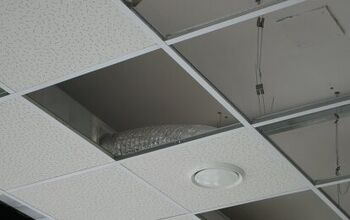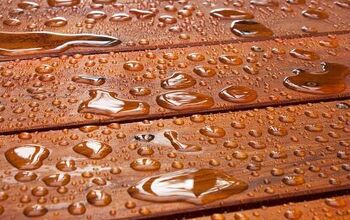Can You Paint Over Water Damaged Ceiling?

It’s not uncommon to have water damage on your drywall, whether it be ceiling or walls, especially if you live in an area that experiences heavy rainfall. If you have water damage on your ceiling, you have probably wondered if painting over the problem area is a practical solution. After all, simply applying a couple of coats of paint is far easier than replacing ceiling material.
While it is possible, there are some steps that need to be done first. Before you paint over a water damage ceiling, it is always a good idea to identify and address the underlying cause of the water damage.
You can paint over a water-damaged ceiling if isn’t sagging. Never paint over a water-damaged ceiling if the drywall is weak for safety and structural purposes. Prime the ceiling with stain-blocking primer before you paint it if it’s not sagging or weakened.
Do You Need to Hire a Paint Contractor?
Get free, zero-commitment quotes from pro contractors near you.

How To Paint Over A Water Damaged Ceiling
- Address the cause of the water damage
- Repair the ceiling material, if needed
- Tackle mold concerns
- Prime with stain-blocking primer
- Paint the ceiling
One of the first things that you should do when you first spot a water stain on your ceiling is to look for and fix the root of the problem. You should not paint over the stain without looking deeper into the issue.
While there are many ways that you can successfully cover and paint over a water stain, the solution is not likely to last long if the underlying problem is not taken care of first.
Where Do Water Stains On A Ceiling Come From?
Water damage comes from a surprising number of sources and the exact location of a leak can sometimes be difficult to pinpoint.
The most common origins of a water stain on your ceiling are leaky roofs, pipes, and heating/cooling appliances. You can find the source of the leak by accessing areas directly above the water stain on a ceiling. Sometimes, however, water will run along sloped surfaces before dripping onto the ceiling from above.
In any case, stopping the leak before you paint over the water stain on your ceiling will save you a lot of time and money in the long run.
Addressing The Cause Of The Water Damage
The first step in addressing the cause of the water damage is to stabilize the area surrounding the leak. Take valuables out of the space and bring in a bucket to catch any water that may be escaping onto the floor. If your ceiling covering is drywall, which it often is, it’s going to either disperse or absorb this water. In this case, you’ll want to pierce a hole in the ceiling to allow the water to exit and land in your bucket.
Next, you’ll want to identify and repair the source of the problem. It may be a loose supply line, leaking drain, or failed caulk. Regardless, you’ll need to cut a hole in the ceiling to get a better look. Attempt to re-create the leak or use sheets of toilet paper along the ceiling joists and pipes to track down the issue much easier.
Once repaired, allow all affected materials to dry completely before you proceed. After you replace the ceiling material, you want to avoid any residual moisture that could cause mold growth.
How To Repair A Water Damaged Ceiling
Once you identify the source of the water stain and solve the leakage issue, it is time to get the affected area ready for paint.
Step 1: Repair The Ceiling Material
Depending on the significance of the leak, this may mean a simple touch up or replacing the entire ceiling. If you had to cut into your ceiling to identify and fix the cause of the problem, you need to repair the ceiling material.
Also, extensive water damage stains on your ceiling likely caused damage to the ceiling material. Warping is common, as are cracks, holes, and other forms of degradation. Before paint can be applied, these areas should be fixed or replaced.
Step 2: Dry The Area Completely
If the ceiling material does not need to be replaced, ensure that the area is completely dry before applying paint. Before you proceed, you need to not only remove all the water you can visually see, but also any dampness or moisture that may exist inside the ceiling.
There are several methods that you can use to dry a ceiling quickly, including fans, dehumidifiers, and portable heaters. These devices can help to significantly speed up the drying process so you can get to painting.
Step 3: Kill Mold and Mildew
If the water stain has been on your ceiling for a long time, the presence of mold or mildew is highly likely. If you do not eradicate mold before painting a water stain, it will eventually have a negative impact on your new coat of paint.
Several good products are available to kill and cover mold. However, you may want to consider hiring a professional for this step, as many sprays that are used as mold killer can be toxic.
Step 4: Clean the Water Stain
Once the mold (if present) is under control, you will still need to clean the stain as well as possible before applying new paint. One of the best ways to do this is to use a bleach solution, as the bleach will help reduce the appearance of the stain. Once cleaned, the site will need additional time to dry out, once again.
Step 5: Prime the Ceiling
Once the ceiling is ready for paint, there is still one more step to take care of before applying a coat of paint. As water stains have a tendency to show up through paint (even after the problem has been fixed), using a stain-blocking primer will help you put an end to the stain.
Simply spray, brush, or roll the primer on as you would with paint. Allow the primer to dry, and then get ready to paint your ceiling.
Step 6: Paint the Water Stained Ceiling
After completing all the preliminary steps required for covering a water stain on your ceiling, it is time to apply a couple of coats of paint.
One thing to remember when doing this is that matching paint – especially when it is older – is a challenging thing to do. It is often easier to paint the entire ceiling with at least two coats of paint to ensure complete and even coverage.
Do You Need A Professional To Paint Over Water Stains?
By now, you are probably wondering if you can paint over a water stain on your ceiling by yourself or if you should hire a professional.
The answer, of course, will change from person to person for a variety of reasons. The first of which is how experienced you are with the required skillsets. It is one thing to paint over a water stain on your ceiling, but it is entirely different if you need to repair plumbing, replace ceiling material, or effectively kill mold.
Underlying Issues Require Professional Assistance
When complex underlying issues cause the water stains on your ceiling, getting the help of a professional will make the job easier in many ways.
That said, the cost of hiring a contractor can be quite high and finding the right one can also prove challenging. If you can solve the underlying problem yourself, then painting over water stains is a simple enough process that any capable DIY’er can handle.
Useful Products To Paint Over Water Stains
When it comes to water damage, the two product types that are most important are those that kill mold and mildew and those that cover stains. If not eradicated, mold will most likely cause problems in the future. Likewise, if a good primer is not used, water stains will show through new paint over time.
- Mold Control: Mold Bomb Fogger, Sporicidin Disinfectant Solution, and Concrobium Mold Control are all popular products used to kill mold and keep it from coming back.
- Primer: Kilz Restoration, Kilz Original, and Zinsser Mold Killing Primer are all fantastic choices when it comes to products designed to keep water stains from coming back. Related Questions
Do You Need to Hire a Paint Contractor?
Get free, zero-commitment quotes from pro contractors near you.

Related Questions
Can you paint over water stains on the ceiling?
In short, yes. It is certainly possible to paint over water stains on your ceiling. The primary consideration is how permanent the cover-up will be. If the underlying problem has not been fixed, the water stains are very likely to reveal themselves again.
Can you paint over water-damaged plaster?
Yes, you can paint over water-damaged plaster. The process is similar to that of painting over a water-stained ceiling. You should solve the underlying water leak, clean, dry, and prime the affected area, and then you can paint over water-damaged plaster.
How can I block water stains?
The best solution if you are faced with a water leak is to find the source of the leak and conduct the necessary repairs. Then, using a sealant and primer you can affectively block water stains from showing through your paint job.

Benjamin is a proud homeowner who loves to write about DIY projects and home improvement projects. Traveling, perfecting his home, and spending time with his family are just a few of the many things that keep him inspired.
More by Benjamin Wright



























